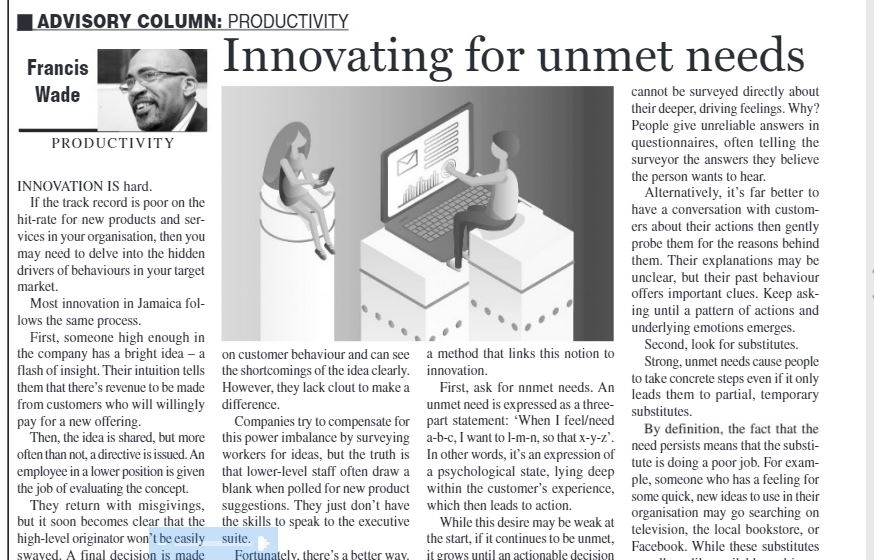Innovation is hard. What is the hit-rate like for new products and services in your organization? If the track record is poor, then you may need to delve into the hidden drivers of behaviors in your target market.
Most innovation in Jamaica follows the same process. First, someone high enough in the company has a bright idea – a flash of insight. Their intuition tells them that there’s revenue to be made from customers who will willingly pay for a new offering.
Then, the idea is shared, but more often than not, a directive is issued. An employee in a lower position is given the job of evaluating the concept. They return with misgivings but it soon becomes clear that the high-level originator won’t be easily swayed. A final decision is made to proceed.
However, when the product fails in the market, everyone is mystified, except those employees closest to the prospects. They have their pulse on customer behavior, and can see the shortcomings of the idea clearly. However, they lack enough clout to make a difference.
Companies try to compensate for this power imbalance by surveying workers for ideas, but the truth is that lower-level staff often draw a blank when polled for new product suggestions. They just don’t have the skills to speak to the executive suite. Fortunately, there’s a better way.
At the heart of Tony Ulwick’s “Jobs to be Done” theory is the idea that everyone is going about their daily routine trying to get certain tasks executed. Here is a method that links this notion to innovation.
1. Ask for Unmet Needs
An “unmet need” is expressed as a three-part statement: “When I feel/need__________ I want to ____________ so that____________.” In other words, it’s an expression of a psychological state lying deep within the customer’s experience which then leads to action.
While this desire may be weak at the start, if it continues to be unmet it grows until an actionable decision is made.
Consider that customers of your company are a walking bundle of unmet needs. Normally, your marketing department would simply assign them to a well-defined segment. Set that approach aside and, instead, start looking for unmet, emotional drivers.
The challenge is that customers cannot be surveyed directly about their deeper, driving feelings. Why? People give unreliable answers in questionnaires, often telling the surveyor the answers they believe the person wants to hear.
Alternately, it’s far better to have a conversation with customers about their actions, then gently probe them for the reasons behind them. Their explanations may be unclear, but their past behaviour offers important clues. Keep asking until a pattern of actions and underlying emotions emerges.
2. Look for Substitutes
Strong unmet needs cause people to take concrete steps, even if it only leads them to partial, temporary substitutes.
By definition, the fact that the need persists means that the substitute is doing a poor job. For example, someone who has a feeling for some quick, new ideas to use in their organization may go searching on television, the local bookstore or Facebook. While these substitutes are all readily available and inexpensive, they are time consuming and foreign, so the need never gets fulfilled.
Therefore, your new product or service should be so well-crafted that it displaces the substitutes currently in use. They are, in fact your real enemies.
Take this fortnightly business column as an example. At first blush, you may think that another newspaper represents the competition. However, when I performed the Ulwick analysis I realized that the real competitors are television, books and Facebook.
From a traditional point of view, these conclusions makes no sense. Yet, in the customer’s world, the psychological gap that drives them to these substitutes has its own, perfect logic.
3. Use Benefit Statements
Closing the psychological gap isn’t easy. In fact, innovators often have a difficult time articulating the emotional-filled reasons their new product or service improves the customer’s life.
However, once the unmet needs and substitutes are known, the task becomes easier. For example, one benefit of reading this column regularly might be that “It gives you fresh ideas for your Jamaican organization with a minimum investment of effort, so you don’t have to waste precious time searching the internet.”
Contrast this approach with that taken by traditional marketers who imagine distinct market segments. These are usually formed around demographic data such as “an employed woman between the ages of 30-45 with two children and a bachelor’s degree.” Unfortunately, segments don’t work as well because people are actually individually and psychologically motivated by unmet needs in particular circumstances. Not by generic characteristics.
In summary, use these three insights to dramatically improve your connection with your prospect’s hidden motivators.
http://jamaica-gleaner.com/article/business/20191117/frances-wade-innovating-unmet-needs

